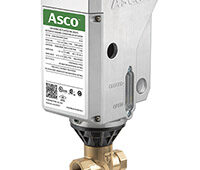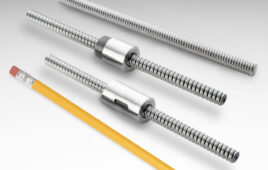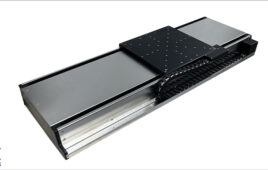The evolution of large format digital printers continues to drive change in the printing and publishing markets. These large format machines are used to print everything from banners, posters, signs, and photographs to proofs, drawings, and textiles. As digital printers continue to improve in terms of cost, performance, quality, and speed, they are beginning to replace traditional analog sign and display technologies, such as screen-printing.
Gandy Digital, San Antonio, Tx. specializes in the design and manufacture of large format digital printers. With manufacturing facilities in Oakville, Ont. its engineering team explored different options that address issues of cost, design simplicity, and minimizing the inertial mismatch apparent in earlier printer generations. Gandy currently sells one product, the Pred8tor, a hybrid, ultraviolet (UV), flatbed and roll-to-roll, print machine. This large format, digital printer, prints high-resolution images on a 4 x 8 ft. sheet of flat media at speeds not possible with earlier printers. This machine achieves high speeds and improved print quality using new print head technology, streamlined software algorithms, an iPad user interface, and advanced motion control components. An automated head cleaning system eliminates the task of cleaning print head nozzles before printing, while a vacuum surface on the flatbed keeps rigid or delicate substrates perfectly flat for precise printing. In addition, the machine can be used to replace conventional high-speed printing presses in a fraction of the space.

ServoNut Power Modules are available as a standalone drive element or as a complete precision linear actuator
Precise motion control is a critical aspect of achieving the Pred8tor’s print quality. The two main motion axes include the print table, which moves forward and backward, and the print head, which moves left and right. In earlier printer generations, linear motors were used on both axes. Although linear motors on the high-speed print head axis worked as expected, this approach caused several issues on the table axis. One was the use of a linear motor on the table axis, which required the use of a linear encoder as well. This method added several hundred dollars of cost to the bill of materials. The linear encoder was also difficult to install and service on this axis, requiring additional downtime during maintenance intervals.
To find a solution for moving the table axis, Gandy’s engineers teamed up with Bell-Everman Inc., Goleta, CA engineers. Having worked on a few custom machine projects with Bell-Everman (a high-precision motion component supplier), they recommended the ServoNut power module. The module mates a high-performance NEMA 23 motor directly onto a zero-backlash precision ball screw. In this design, the screw remains stationary while the nut is rotated to achieve linear motion. This design allows higher speeds and longer strokes than in traditional ball screw applications. A simple rotary encoder supplies position feedback. Compared to using a linear motor, the module’s low-inertia, high-force driven nut design offered greater load capacity, acceleration and speed, as well as easier installation and lower cost.

For the new Pred8tor flatbed UV inkjet printer, cost, precision, and simplicity are the prime selection criteria when specifying motion control
The Pred8tor has a 10-mm pitch high-precision, ball screw for the table motion, while the linear motor drives the print head axis. The table axis is unusually long for an unsupported screw, yet the design achieves smooth motion. The rotary encoder on the motor commutates the ServoNut. The printer prints using a 6-picoliter dot size at 900 dots per in. The table weight is 200 lb unloaded, and the factory indexing accuracy specification is ± 2 in. The module is driven with a proprietary jerk-limiting algorithm resulting in smooth acceleration and deceleration, while reducing forces.
Bell-Everman
www.bell-everman.com
Filed Under: Actuators, Encoders • linear, Encoders (rotary) + resolvers, LINEAR MOTION





Tell Us What You Think!